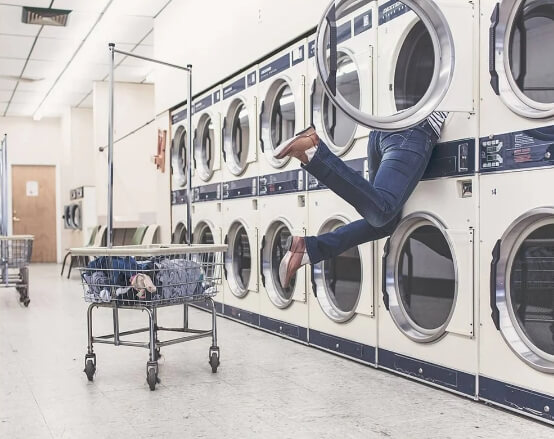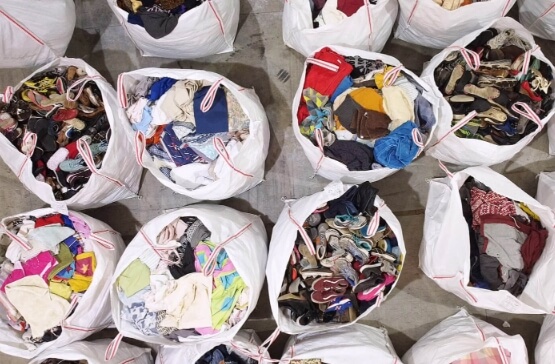When shopping secondhand, the thrill of finding one-of-a-kind items is undeniable. But before you wear your new-to-you clothing, it’s crucial to follow the right cleaning and sanitization process. Proper secondhand clothes care ensures that any hidden dirt, bacteria, or allergens are removed, allowing you to enjoy your thrift finds with confidence. Let’s explore how to make secondhand fashion not only stylish but also safe.

Step 1: Pre-Wash Inspection
Before diving into the cleaning process, a thorough pre-wash inspection is a crucial part of secondhand clothes care. Start by checking the fabric type and reading the care labels to ensure you’re using the right washing methods. Delicate materials like silk or wool may require hand washing, while sturdy fabrics like cotton or denim can handle machine washing. Additionally, inspect for any stains, loose threads, or minor damage that might need attention before washing. Taking these steps not only helps preserve the quality of your thrifted items but also ensures they are cleaned effectively and safely.
Identifying Fabric Types and Care Labels
Understanding the fabric types of your thrift store finds is an essential step in secondhand clothes care. Each fabric requires a different cleaning approach, so it’s important to check the care labels before washing. Natural fibers like cotton and linen are generally more durable and can be machine washed, while delicate fabrics such as silk or wool often need gentler hand washing or dry cleaning. By following the recommended care instructions, you can avoid damaging the fabric and ensure that your secondhand clothes stay in great condition for longer.
Checking for Stains, Damage, and Alterations
Another key aspect of secondhand clothes care is carefully inspecting your garments for stains, damage, or alterations before washing. Look for any visible stains that may require spot treatment, and check for loose buttons, seams, or zippers that might need repair. Additionally, alterations like hem adjustments or added patches could affect how you clean the item. Addressing these issues early ensures that your thrifted pieces are properly cleaned and maintained, making them safe and ready to wear after washing.
Step 2: Choosing the Right Cleaning Methods
Choosing the right cleaning method is a vital part of secondhand clothes care. The fabric type will largely determine whether you should machine wash, hand wash, or even dry clean your thrifted garments. For sturdier fabrics like cotton or polyester, machine washing with a mild detergent is typically safe. However, more delicate materials such as silk or lace should be hand washed in cold water to prevent damage. Additionally, consider using eco-friendly detergents and washing practices to protect both your clothes and the environment. By selecting the proper cleaning method, you can extend the life of your secondhand pieces while keeping them fresh and clean.
Machine Washing vs. Hand Washing
When it comes to secondhand clothes care, knowing whether to machine wash or hand wash your thrifted items can make a big difference in maintaining their quality. Machine washing is ideal for sturdy fabrics like cotton, denim, and polyester, which can handle the rigors of a wash cycle. However, for more delicate materials like silk, wool, or lace, hand washing is a safer option, as it reduces the risk of stretching or tearing. Always check the care labels to determine the best washing method and ensure your secondhand clothes remain in great shape.
Using Gentle Detergents for Delicate Fabrics
In secondhand clothes care, the type of detergent you use plays a crucial role, especially for delicate fabrics. Opt for gentle, fragrance-free detergents that are formulated for sensitive materials. These detergents help protect the fibers while effectively cleaning your garments. Harsh chemicals in standard detergents can weaken delicate fabrics, causing them to lose their shape or become damaged over time. By using the right detergent, you can keep your thrifted treasures looking their best without compromising their longevity.
Green Cleaning Options for Eco-Conscious Shoppers
Eco-conscious shoppers can elevate their secondhand clothes care routine by choosing green cleaning options. Eco-friendly detergents made from natural ingredients are not only safer for your garments, but they also reduce your environmental footprint. Additionally, cold water washing and air drying can help conserve energy and extend the life of your secondhand clothes. By integrating sustainable cleaning practices, you can care for your thrifted items while supporting a greener, more environmentally friendly lifestyle.
Step 3: Sanitizing Your Thrift Store Finds
Sanitizing your thrift store finds is a crucial step in secondhand clothes care, ensuring that your garments are free from bacteria, allergens, and odors. After washing, consider using additional sanitization methods like adding white vinegar or baking soda during the rinse cycle to naturally kill germs and neutralize smells. For items that can’t be machine washed, steam cleaning or using a fabric-safe disinfectant spray can be effective alternatives. By taking the extra step to sanitize your secondhand clothes, you can feel confident that they’re not only clean but also safe to wear.

Removing Bacteria and Allergens
A key aspect of secondhand clothes care is removing bacteria and allergens that may linger on pre-owned garments. Washing clothes in hot water, when the fabric allows, is an effective way to kill most bacteria. For sensitive fabrics that can’t withstand high temperatures, adding natural cleaning agents like white vinegar or tea tree oil can help eliminate germs while being gentle on the fabric. Properly addressing bacteria and allergens ensures that your thrift store finds are not only clean but also safe for daily wear.
Best Practices for Sanitizing Secondhand Clothing
Sanitizing is a critical part of secondhand clothes care, especially for those who want their thrifted items to feel as fresh as new. Start by thoroughly washing the clothes, then use a steam cleaner or tumble dry on high heat if the fabric allows. These methods help kill lingering bacteria and dust mites. For items that are too delicate for machine treatments, spraying them with a fabric-safe disinfectant or hanging them in direct sunlight can be effective alternatives. Following these best practices will ensure your secondhand wardrobe is properly sanitized.
Effective Use of Disinfectants and Natural Solutions
In secondhand clothes care, knowing how to effectively use disinfectants and natural solutions can make a big difference. Commercial fabric disinfectants are great for killing germs, but natural alternatives like hydrogen peroxide, baking soda, and essential oils are also powerful yet gentle options. Simply adding these natural solutions to your wash cycle can help remove odors and bacteria without damaging the fabric. Incorporating both chemical and natural methods into your sanitization routine ensures your thrifted clothes remain fresh, clean, and safe to wear.
Step 4: Drying and Storing Your Secondhand Clothes
Drying and storing your clothes properly is an essential part of secondhand clothes care, helping to maintain the longevity and freshness of your thrifted finds. For most fabrics, air drying is the best option, as it minimizes shrinkage and preserves the shape of the garments. If using a dryer, select a low heat setting to avoid damaging delicate fibers. Once dry, store your clothes in a cool, dry place, preferably using breathable fabric bags to prevent moisture buildup. Proper drying and storage techniques ensure your secondhand clothes stay fresh and ready to wear for years to come.

Air Drying vs. Machine Drying
In secondhand clothes care, the drying method you choose can have a significant impact on the longevity of your garments. Air drying is ideal for most fabrics, as it helps prevent shrinkage and reduces wear and tear caused by high heat. Delicate items like silk, lace, or wool should always be air dried to preserve their shape and texture. However, for sturdier fabrics such as denim or cotton, using a low-heat machine drying cycle can be convenient. By selecting the right drying method, you can ensure your thrifted clothes remain in top condition for longer.
Proper Storage Techniques to Maintain Freshness
Storing your secondhand clothes correctly is a crucial part of secondhand clothes care. Once your garments are clean and dry, it’s important to store them in a way that maintains their freshness. Use breathable fabric bags or cotton covers to protect your clothes from dust while allowing airflow, which helps prevent mold and mildew. Avoid overcrowding your closet to prevent wrinkles and allow your garments to stay fresh and ready to wear. These storage techniques will keep your thrift store finds looking great and lasting longer.
Step 5: Dealing with Tough Stains and Odors
Dealing with tough stains and odors is an important part of secondhand clothes care, especially when thrifted items come with visible marks or persistent smells. For stubborn stains, pre-treating the area with a stain remover or a mixture of baking soda and water can help lift the stain before washing. Odors, particularly musty or smoke smells, can often be eliminated by soaking the garments in a solution of white vinegar and water or adding baking soda to the wash cycle. Tackling these issues with the right techniques ensures your secondhand clothes are fresh, clean, and ready to be worn again.
Removing Persistent Stains and Smells
In secondhand clothes care, persistent stains and smells can sometimes be the biggest challenge. Stubborn stains, like grease or ink, often require extra attention. Pre-treat the affected area with a stain remover or a simple DIY solution of baking soda and water, letting it sit before washing. For smells that linger, especially musty or smoky odors, adding a cup of white vinegar to the wash cycle can help neutralize them. By taking these steps, you can ensure that even the toughest stains and odors don’t diminish the quality of your thrifted clothes.
DIY Remedies for Odor Elimination
A key part of secondhand clothes care is eliminating odors naturally without harsh chemicals. Simple DIY remedies like soaking clothes in a mixture of white vinegar and water can work wonders for neutralizing unpleasant smells. Baking soda is another powerful odor remover—just add half a cup to your regular laundry detergent to help refresh your garments. For a fresh, long-lasting scent, consider using a few drops of essential oils during the final rinse. These natural solutions are gentle on fabrics while effectively getting rid of any unwanted odors.
